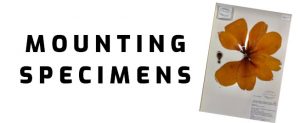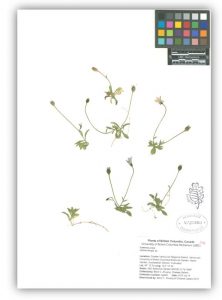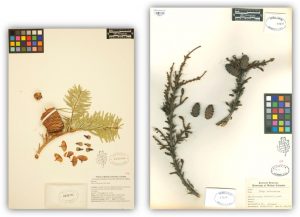
The way you mount a specimen depends on the purpose of your specimen. Archival quality supplies can preserve the specimen longer. The following equipment and procedures are often applied to herbarium specimens.
Overview of Procedure for Vascular specimens:
Arrange specimen
- Place specimen on a 11.5 x 16.5 inch piece of archival, herbarium paper.
- If possible, leave a 1.5 inch border around the specimen. Keeping the specimen away from the edge helps to avoid damage from handling and UV light exposure.
- Make sure to leave room for:
- Specimen label, in the lower right corner.
- Fragment pack (if using), in the upper left corner.
- Annotations; lower left area of herbarium paper is usually reserved for annotations.
- Try to place the specimen on the lower half of the archival paper so that the sheet is balanced with the heavier portion on the lower half. This prevents the sheet from bending while being handled, thereby helping to avoid specimen damage.
- Make sure to keep collector’s tag with specimen (if present).

Specimen label
- Glue to lower right corner.
- Check to see if collection # on label matches the specimen’s collection # (often found on newspaper that the specimen comes in).
- Use sparing amounts of archival glue – too much will make the label wrinkly.
- If label won’t fit in bottom right corner, then you can glue down one side of the label (usually the vertical right edge of label) so that the label may be lifted to examine the specimen.
Fragment packs
- Glue to upper left corner.
- Fragment packs can be used to hold detached fruits, small flowers and extra leaves which could be used in genetic analysis.
Mounting Specimen
- Use archival tape and glue.
- Archival tape is preferred, as it can easily be removed without damaging the specimen (unlike glue).
- Archival tape must be cut into appropriate sized strips and wetted before applying (the yellowed side is the adhesive side).
- If there is only one flower present DO NOT glue it, instead use archival tape.
- Leaves can be glued by applying a small dab of glue between the tip and middle of the leaf.
- See Additional Tips & Examples for examples on when and where to use glue.

Additional Tips & Examples:
- Mount the side of the plant that best shows key characters (flowers, leaves, fruits, etc) facing up. Sometimes but not often, collectors press and arrange the plant in the way they prefer them to be mounted.
- Depending on space, some individuals can be mounted upside down.
- Think about the areas you want to tape down and which areas will lift off the paper when you pick it up.
- Areas that you tape down will put pressure on the specimen and are more likely to snap at these points.
- Although you may see it in some examples, avoid taping across multiple parts.
- Large specimens are sometimes folded to fit a herbarium press.

Gluing Leaves
- Refer to red circle on where leaves are glued down.

With bulky stem or bulbs
- A small amount of glue can be applied to thick/bulky stems and bulbs (circled in red) with a tape across to secure.

Overlapped specimens
- Labels are glued on the right-hand side, but do not glue down the areas that overlap with the specimen.
- Glue should NOT be applied to the overlapped areas of the specimen, use tape instead.

Small individual plants
- Use tweezers to carefully separate each individual if possible. Tape most of the individuals and a few can be glued.
- Small and fragile plants can also be mounted in large fragment packs.

Ferns
- Ferns should be mounted to show both sides of the fond (the sori on the underside are key characters).

Conifers
- Cones are usually very bulky and should be glued and taped. Individual scales can be glued or tape a few and the rest should be put into a fragment packet.
- Large cones can also be stored in a properly labelled box so that the box can be connected back to the specimen mounter on paper.
- Needles of some conifer species are deciduous and can fall off very easily; glue some of the needles on the sheet and the rest can be stored in a fragment packet.

